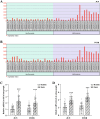Dysregulation of c-Jun (JUN) and FBJ murine osteosarcoma viral oncogene homolog B (FOSB) in obese people and their predictive values for metabolic syndrome
- PMID: 39284711
- PMCID: PMC11778360
- DOI: 10.1507/endocrj.EJ24-0256
Dysregulation of c-Jun (JUN) and FBJ murine osteosarcoma viral oncogene homolog B (FOSB) in obese people and their predictive values for metabolic syndrome
Abstract
The incidences of metabolic syndrome (MetS), denoting insulin resistance-associated various metabolic disorders, are increasing. This study aimed to identify new biomarkers for predicting MetS and provide a novel diagnostic approach. Herein, the expression profiles of c-Jun (JUN) and FBJ murine osteosarcoma viral oncogene homolog B (FOSB) in individuals with obesity and patients with MetS from the Gene Expression Omnibus database. Quantitative reverse transcription polymerase chain reaction (RT-qPCR) was used to evaluate the messenger RNA levels of JUN and FOSB in the peripheral blood of healthy volunteers (lean and obese) and patients with MetS (lean and obese), along with that in the adipose tissue and peripheral blood of obese mouse model. Furthermore, receiver operating characteristic (ROC) curve and logistic regression analyses were performed to determine the diagnostic value of JUN and FOSB in MetS. The expression profiles and RT-qPCR results showed that JUN and FOSB were highly expressed in individuals with obesity, obese mouse models, and patients with MetS. The ROC analysis results showed an area under the curve values of 0.872 and 0.879 for JUN, 0.802 and 0.962 for FOSB, and 0.946 and 0.979 for JUN-FOSB in the lean group and the group with obesity, respectively, in predicting MetS. Logistic regression analysis showed that the p-values of both JUN and FOSB as MetS-affecting factors were <0.05. Altogether, the findings of this study indicate that both JUN and FOSB, abnormally expressed in individuals with obesity, are good biomarkers of MetS.
Keywords: Diagnosis; FBJ murine osteosarcoma viral oncogene homolog B (FOSB); Metabolic syndrome; Obesity; c-Jun (JUN).
Conflict of interest statement
None of the authors have any potential conflicts of interest associated with this research.
Figures



Similar articles
-
Specific preservation of biosynthetic responses to insulin in adipose tissue may contribute to hyperleptinemia in insulin-resistant obese mice.J Nutr. 2004 May;134(5):1045-50. doi: 10.1093/jn/134.5.1045. J Nutr. 2004. PMID: 15113943
-
Evaluation of Transcriptomic Regulations behind Metabolic Syndrome in Obese and Lean Subjects.Int J Mol Sci. 2020 Feb 20;21(4):1455. doi: 10.3390/ijms21041455. Int J Mol Sci. 2020. PMID: 32093387 Free PMC article. Clinical Trial.
-
Circ_0021087 acts as a miR-184 sponge and represses gastric cancer progression by adsorbing miR-184 and elevating FOSB expression.Eur J Clin Invest. 2021 Nov;51(11):e13605. doi: 10.1111/eci.13605. Epub 2021 Jun 2. Eur J Clin Invest. 2021. PMID: 34076278
-
AP-1 protein induction during monopoiesis favors C/EBP: AP-1 heterodimers over C/EBP homodimerization and stimulates FosB transcription.J Leukoc Biol. 2011 Oct;90(4):643-51. doi: 10.1189/jlb.0111043. Epub 2011 May 4. J Leukoc Biol. 2011. PMID: 21543584 Free PMC article.
-
Regulation of the MIR155 host gene in physiological and pathological processes.Gene. 2013 Dec 10;532(1):1-12. doi: 10.1016/j.gene.2012.12.009. Epub 2012 Dec 14. Gene. 2013. PMID: 23246696 Review.
References
-
- Seravalle G, Grassi G (2017) Obesity and hypertension. Pharmacol Res 122: 1–7. - PubMed
-
- Ortega FB, Lavie CJ, Blair SN (2016) Obesity and cardiovascular disease. Circ Res 118: 1752–1770. - PubMed
-
- Koliaki C, Liatis S, Kokkinos A (2019) Obesity and cardiovascular disease: revisiting an old relationship. Metabolism 92: 98–107. - PubMed
-
- Snyder S, Turner GA, Turner A (2014) Obesity-related kidney disease. Prim Care 41: 875–893. - PubMed
-
- Craig JR, Jenkins TG, Carrell DT, Hotaling JM (2017) Obesity, male infertility, and the sperm epigenome. Fertil Steril 107: 848–859. - PubMed
MeSH terms
Substances
LinkOut - more resources
Full Text Sources
Medical
Miscellaneous

